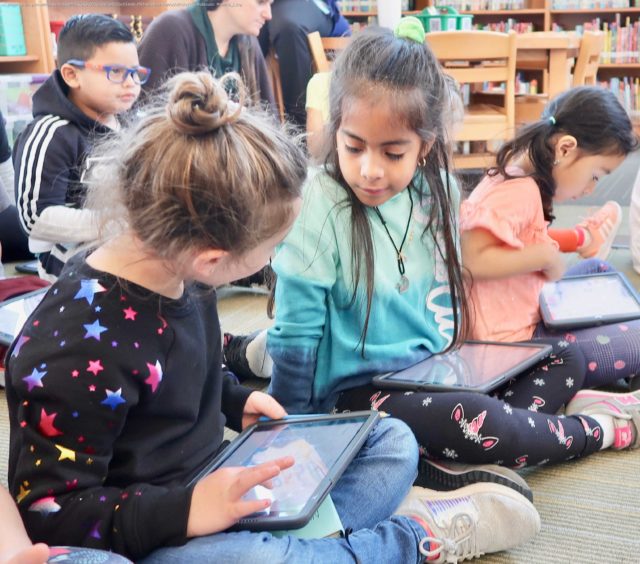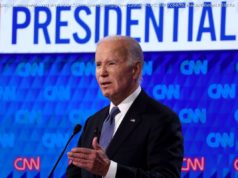This story about technology in schools was produced by The Hechinger Report, a nonprofit, independent news organization focused on inequality and innovation in education. Sign up…
This story about technology in schools was produced by The Hechinger Report, a nonprofit, independent news organization focused on inequality and innovation in education. Sign up for Hechinger’s newsletter.
MINEOLA, N. Y. — Earlier this school year, the first graders at the Hampton Street School were about to take a coding class, something they’ve been doing since kindergarten. “Coding gives us another way to solve our problems,” Diane Nodell, the library media specialist, reminded them. “Are you ready to learn the basics?”
The children were. They opened their iPads and within minutes were following arrows around the grid on their tablets, producing different colors with each set of directions. As they worked, Nodell assured them the assignment was helping their brains. “You’re going to grow neurons,” she said.
The coding lesson, with students tapping away on individual iPads, was typical in the Mineola Union Free School District in the New York City suburbs. For almost a decade, even young kids here have spent hours a day on screens as Mineola’s educators sought to transform schooling here.
Mineola was more prepared than most districts when the coronavirus shuttered schools around the country, forcing children everywhere to spend more time on screens, trying to keep up with school work or just keep busy. Few other districts had embraced the promise of technology as enthusiastically as this Long Island district. Each student already had a device that all but the youngest took home every day, and some spent hours a day working online in school. Children and teachers were familiar with a variety of learning apps and other educational software. Educators had years of experience integrating technology into their teaching.
Superintendent Michael Nagler said a teacher told him, “Little did we know, but we’ve been preparing for a moment like this for years.”
Mineola’s experience could become even more valuable. Some proposals have suggested students will continue to spend some days learning at home when schools reopen in the fall. At the least, schools are only likely to use more technology, not less.
Reopening plans: Scheduled days home, more online learning, lots of hand-washing
Last week, New York Gov. Andrew Cuomo announced he would work with the Bill & Melinda Gates Foundation and other technology experts “to reimagine” education in the state — and give technology a greater role.
“I believe that many of the systems that Mineola currently has in place would be exemplars,” Nagler wrote in an email. He said has not heard from either Cuomo or Gates. (The Gates Foundation is among the many supporters of The Hechinger Report and USA TODAY’s education coverage.)
For a more tech-focused school system to work, Nagler said the state needs to create more infrastructure, such as a centralized guide to online courses, to help schools get there.
The Cuomo administration has recruited experts but hasn’t yet outlined details for how technology might address various concerns about education in New York, such as inequality. Cuomo, who appeared to question this week whether students have to be in classrooms at all, drew immediate fire from many educators and parents, and his secretary later wrote on Twitter that “nothing could ever replace in-person learning.” Nagler said maybe the governor should have been clearer, but that even those who may resist remote learning and technology now could change their minds. “Parents don’t see the benefits when you introduce them,” he said, adding that when something like coronavirus happens, that changes.
‘Mama is tired’:After school closures, some families burn out on online classes. Others thrive
And yet, even in a place like Mineola where classrooms were already steeped in technology, educators are well aware that computers can’t do everything. The district’s experience and its new efforts to educate children largely confined to their homes for the remainder of the school year highlight both the possibilities and the restrictions of using technology to deliver an adequate education to millions of American children.
Even Nagler, the tech enthusiast behind Mineola’s shift online, has been quick to point out the limits of what his district can do now that school buildings are closed. “This is not school. It’s a bridge,” he said shortly after schools closed. Whatever schools do now, he said, “it has to be about social and emotional learning, not about sending home enough work to keep [students] busy.”
On a rainy day last November, the library at Mineola High School had more than enough online and off-line activities to keep students occupied. While some read or even colored, four girls donned virtual reality headsets and in an adjacent studio Pamela Lopez, an English language learner, worked on a podcast on dub step music. “Dancing to dub step makes your neck muscles stronger,” she said into a microphone.
It was the kind of report students traditionally deliver orally to their classmates. But library media specialist Jeffrey Appelbaum thought podcasts provide a personal presence and let students send their work out to the world. He described how students created a podcast featuring an interview with a World War II veteran. “He’s 89 years old, so this is the way to archive a community member,” Appelbaum said.
Home
United States
USA — Science This tech-savvy school shares tips for online learning amid coronavirus pandemic






